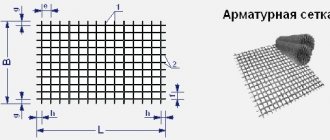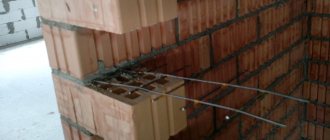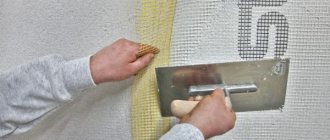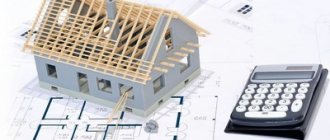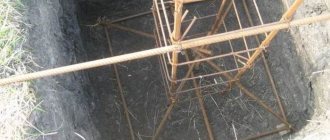- 1 Why is reinforcement necessary?
- 2 What needs to be reinforced?
- 3 Tools and materials
- 4 Technology
- 5 Reinforcement of window and door lintels
- 6 Features of reinforcement of oblique walls
- 7 Recommendations
- 8 Conclusions
Aerated concrete has high thermal insulation and sound insulation properties and is light in weight, which simplifies transportation and work with the material. The building material is also considered environmentally friendly, easy to work with and install. The disadvantages of aerated concrete include hygroscopicity and low strength. Contact with water for a long time may cause the material to become wet. This can lead to a decrease in the density and thermal insulation properties of the building material.
Reinforcement of aerated concrete building.
The use of aerated concrete blocks allows you to significantly increase the pace of construction work and at the same time save money that could be spent on additional insulation of the walls. Products made from this building material are widely used for the construction of low-rise and high-rise buildings, as they have high technical performance, which can be improved by reinforcing aerated concrete masonry. Builders use reinforcement both in the construction and strengthening of walls and for leveling aerated concrete masonry.
Openings
Changing the floor plan is done quite often these days.
To do this, they began to create openings in concrete partitions that were not planned by the project. This job was once quite difficult to do, but with the advent of new tools, creating an opening in a concrete wall has become much easier and faster.
Consider in the article how you can make an opening in a concrete wall, if it is monolithic or made of panels.
Tools and materials
To reinforce monolithic walls, you should prepare:
- Mortar for pouring load-bearing structures. High quality concrete is used, prepared independently or purchased from a specialized organization for the production and sale of building materials.
- Fittings. To create a reinforcing frame, steel rods, composite elements, and fiberglass are selected.
- Tools and materials for connecting frame fragments. Welding machine, knitting wire, pliers with wire cutters, knitting gun.
- Formwork. These are boards, beams, shields, elements.
- Tools for compacting mortar. Industrial vibrator, improvised means.
The main function of the reinforcement frame is to ensure strength and strengthen those parts of the structure that are subject to the greatest loads.
DIY device
The technology for constructing monolithic walls does not require special skills and abilities. A team of 2-3 people can handle the scope of work. A home handyman with an assistant will save on paying workers.
Formwork
Monolithic walls are erected using formwork - a building structure that is a form for pouring concrete mixture .
There are two types of formwork: removable and non-removable . Removable formwork is rearranged during the pouring process and removed after the concrete has gained strength.
The permanent form remains part of the wall, adding the necessary qualities to the concrete. The most common forms made of foamed polystyrene are made in the form of blocks. The blocks are connected with locks. Expanded polystyrene with concrete forms a three-layer cake, insulates the concrete layer, and soundproofs the structure .
Reinforcement
The reinforcing frame is installed in the adjustable formwork immediately after assembly. In permanent formwork, the reinforcement is calculated and installed by the manufacturer.
A monolithic wall is subject to compressive and bending loads . Concrete acts in compression, while bending deformation is absorbed by reinforcement.
Double monolithic wall frame. In low-rise construction, it is permissible to use reinforcement meshes with a cross-section of 8 mm.
The corrugated section of the rods adheres well to the concrete mixture, the smooth rods are anchored with bends at the ends.
Exit of reinforcement to the surface is not allowed . The maximum pitch of longitudinal reinforcement in the mesh is 25 cm .
The transverse step is limited to a distance of 35 cm . The lengths of the longitudinal reinforcement rods are selected for the entire height of the structure.
If for some reason it is impossible to do without a joint, the reinforcement is overlapped , without the use of welding. The length of the overlap depends on the diameter of the reinforcement and is indicated in the architectural design of the house. Welded joints break due to vibration caused by concrete compaction.
Reinforcing the opening
Any opening weakens the cross-section of the structure and becomes a vulnerable point. The perimeter of window and door openings is additionally strengthened.
The thickness and number of reinforcing bars will depend on the width of the opening, the applied load and are taken according to the design value . Horizontal and vertical planes are reinforced. When laying the concrete mixture, the formwork is supported until the required hardening is achieved.
Fill
Independent work on building a wall begins with assembling the formwork. A frame of reinforcing bars is installed into the form assembled from panels, then the concrete mixture is poured.
The order of filling the walls depends on the type of formwork:
- permanent formwork is filled from the space under the window openings towards the corners of the building;
- the removable form is poured in rows, to a height of no more than 50 cm at a time (for better compaction of the concrete mixture).
In adjustable formwork, the poured concrete is not allowed to fully set in order to obtain a monolithic structure without seams.
In both cases, the corners are carefully filled and vibrated . When supplying concrete using a mechanized method, the speed of movement of the mixture is reduced for high-quality pouring, reducing the cross-section of the hose.
The concrete is compacted with a vibrator, and maintenance is carried out depending on the time of year. In winter, the solution is heated , in summer, in hot weather, the reinforced concrete is watered , preventing cracking. From precipitation, the open part of the mold is covered with plastic film.
After finishing concrete work, it is imperative to check the strength of the concrete.
Foundation
Let's study the general principles of reinforcement of foundations of the most common types in private construction (find out here how aerated concrete is reinforced).
Slab
For its reinforcement, corrugated rod reinforcement with a diameter of 12 millimeters is usually used. Bending loads under load-bearing walls will be significant; If so, good adhesion between steel and concrete plays a decisive role.
What is worth knowing about this type of foundation?
- The thickness of the slab is determined by the number of floors of the house and the material used for construction. It is clear that a log frame will create a much lower bending load than a brick or monolithic concrete structure. As a rule, the thickness of the slab varies from 15 to 30 centimeters.
A nuance: with a small structure, it is permissible to use reinforcing mesh with a cross-section of rods of 6-10 millimeters.
- Reinforcement is always done in two layers. In this case, the lower and upper lattices are not rigidly connected to each other; It is only permissible to use supports that form a gap of the required size.
The structure of the slab foundation.
- By the way, about gaps: the lattice or mesh should not extend to the surface of the concrete anywhere. At the edges between the reinforcement and the formwork there is approximately a 10-centimeter gap; The gratings are separated from the lower and upper surfaces of the slab by a layer of 1.5 - 3 centimeters. To create appropriate gaps, supports made of annealed wire are used.
- The reinforcement is not welded into a lattice, but knitted with the same annealed wire.
- The optimal pitch for rod reinforcement in a slab is 20-22 centimeters. If a ready-made mesh is used, the reduced wire thickness is partly compensated by the smaller mesh size (15 cm).
Tape
The instructions for reinforcing a strip foundation in some points repeat the recommendations for a slab foundation:
- The grating must be present at the top and bottom of the concrete strip.
Why? Remember: reinforcement carries tensile loads; The compressive force is absorbed by the concrete itself. With an uneven load and/or frost heaving, the tape will be subject to bending force (that is, depending on its vector, the lower or upper part of the foundation will stretch).
- Welding is also undesirable in this case: heating worsens the strength properties of the steel. An exception is material whose marking contains the letter C (for example, A500C).
- The thickness of the concrete separating the steel from the ground should not be less than five centimeters.
- The maximum distance between longitudinal reinforcing bars should not be greater than twice the cross-section of the building structural element (wall or column) resting on the foundation and no more than 400 millimeters.
- Transverse and vertical frame elements are required when the foundation height is 150 mm or more (that is, almost always). In this case, transverse and vertical reinforcement is often performed not in sections, but with a single bent clamp with a diameter of 6-8 mm.
- The minimum distance between adjacent rods (excluding splicing of sections) must be greater than their diameter and more than 25 millimeters.
- Corners, cross-shaped and T-shaped connections of foundation sections must be strengthened in such a way as to form not a connection of two separate beams, but a single rigid frame.
What kind of fittings are there?
For different types of foundations with different degrees of load, the required type of reinforcement is used. Let's figure out what materials the reinforcement can be made of. Next there will be a lot of SNiPs, numbers and technical designations, but don’t be alarmed. Just accept that all this data is necessary if you want your building to have a long life.
Steel reinforcement
Made from carbon (consists of iron and carbon, alloying elements are present in very small quantities) and low-alloy steel (an alloy of iron and alloying elements such as nickel, copper, titanium, vanadium, etc. Contains up to 0.25% alloying elements ). Low alloy steel has better mechanical characteristics and is more resistant to corrosion.
According to the type of production, fittings are:
According to the type of surface, the reinforcement is divided:
Reinforcement strength classes:
Outdated fittings class markings according to GOST 5781-82: A-I, A-II, A-III, A-IV, A-V, A-VI.
flowy floor-length skirt
Modern designations of fittings class: A240, A300, A400, A500, A600, A800, A1000.
Composite polymer reinforcement (ARP)
The automatic transmission is made from plastics. Costs more than steel reinforcement. One of the advantages of the composite is that it does not conduct current, weighs significantly less, and is absolutely not afraid of corrosion. It is still rarely used in private housing construction. But are these advantages so important in private housing construction?
The video compares composite reinforcement with steel
Reinforcement structure for a basement wall
The basement walls need high-quality reinforcement, since the weight of the house structures will press on them from above, and the soil surrounding the building will press on them on the sides.
For the walls of a small private basement, the reinforcement can be knitted with your own hands, without the involvement of specialists.
Correct knitting of rods.
In the case of basement walls, it is necessary to make a reinforcing mesh that will have one important quality - elasticity. It is better to use knitting rather than welding. If the foundation of the building moves due to settlement or heaving of the soil, then nothing will happen to the knitted reinforcement network, but the welded one may fall apart if the settlement is too significant.
However, the construction of monolithic basement walls may include both welded and knitted versions of the reinforcing mesh. Which method to choose should be clarified with the specialists responsible for the design of the structure.
The reinforcement cage should not come into contact with the walls of the formwork.
Knitting of reinforcement for basement walls occurs at the intersection of the rods. To do this, you will need to additionally purchase wire, which is used to fasten the rods. In most cases, the diameter of this wire is several millimeters.
To tie the reinforcement, you will need nippers or a special device that will make the work easier and faster. Such a device can only be found from professionals, so you can rent it from the nearest construction company. Regardless of which reinforcement method is chosen, the strength of the basement wall will increase in any case. When pouring concrete, it is very important to pay special attention to the structural units.
As soon as you tie or weld the reinforcing mesh, you need to clean the pre-installed formwork from dirt and dust, and then mark the future location of the mesh on it. Only after all calculations have been carried out can reinforcement be laid inside the structure.
Laying of reinforcement and installation of formwork for a monolithic wall must be carried out without the influence of soil pressure. In other words, it is necessary to free up space on both sides of the formwork for normal work.
Backfilling of soil is carried out only after the reinforcement network is installed in the formwork and filled with cement mortar. The use of excavated soil is not always justified. For backfilling, specially prepared sand or clay is also used. It all depends on the type of soil and the characteristics of the building.
Where in the standards is it stated that if the hole is taken into account in the calculation, then the frame is structural?
Hello! The expert made the following remark: “The openings must be bordered with additional reinforcement with a cross-section no less than the cross-section of the working reinforcement (of the same direction) that is required by calculation, i.e. The area of the reinforcing border bars must be no less than that cut out in the opening.”
Quote from the Guidelines for the design of concrete and reinforced concrete structures made of heavy concrete (without prestressing): clause 3.141. Large holes in reinforced concrete slabs, panels, etc. must be bordered by additional reinforcement with a cross-section no less than the cross-section of the working reinforcement (of the same direction), which is required by the calculation of the slab as continuous.
Judging by the manual, the opening taken into account in the calculation needs to be additionally framed with cut out reinforcement. I can’t imagine how to prove otherwise
Design engineer KM, KZh
In theory, when you calculate, the area of the framing reinforcement should be approximately equal to the cut out area, and the expert intuitively senses this. Referring to the requirements of the structural frame, the expert is trying to point out to you the words of the SCAD developers that the calculation is reference information and is subject to careful analysis, and the designer bears all responsibility. As one expert said, For every unauthorized or withdrawn remark they can be hit with a hat, and if they write something, they will always confirm it later. Therefore, there is no point in arguing with experts, at least on such a trivial issue. Please correct me anyway if there is a threat of downvoting your remark.
I’m not calling for anything, I’m just expressing my personal opinion and the opinion of an expert.
Calculations and design of KZh, KM / PJSC Uralpromproekt
Source
Tools and materials
To reinforce monolithic walls, you should prepare:
- Mortar for pouring load-bearing structures. High quality concrete is used, prepared independently or purchased from a specialized organization for the production and sale of building materials.
- Fittings. To create a reinforcing frame, steel rods, composite elements, and fiberglass are selected.
- Tools and materials for connecting frame fragments. Welding machine, knitting wire, pliers with wire cutters, knitting gun.
- Formwork. These are boards, beams, shields, elements.
- Tools for compacting mortar. Industrial vibrator, improvised means.
The main function of the reinforcement frame is to ensure strength and strengthen those parts of the structure that are subject to the greatest loads.
Strengthening openings
Any opening is a weak point of the structure. Therefore, the perimeters of window and door openings must be additionally strengthened. If this is done incorrectly, the structure will crack and deform.
The dimensions and type of metal structures to reinforce openings are selected according to precise calculations. It is necessary to take into account all the parameters that affect the integrity of the building’s structure: wall material, number of storeys, opening size, type of foundation, roof weight.
There are several ways to reinforce openings in a monolithic wall:
- Reinforcement in one row using channels. This is a standard method that involves anchoring a metal frame to the wall. The width of the channel should be slightly larger than the width of the wall.
- Double-row reinforcement. The idea is to place two channels on the wall, which are then additionally attached and welded to metal plates.
- Strengthening with corners. Metal elements are attached to the edges of the opening. Their internal part is connected using a strip that is fixed in the wall. In such cases, the racks are tightened with pins or welded.
- Box reinforcement. Channels are welded parallel and vertically. A power I-beam serves as the upper element.
- Corner reinforcement. Used when it is necessary to strengthen non-standard openings and openings.
- Combination of methods. Depends on the design features of the openings.
Reinforcing holes in a monolithic wall is a rather complex and responsible process, especially when an opening needs to be made in a load-bearing wall. An incorrectly constructed opening can lead to a significant reduction in the reliability of the building. Therefore, it is better to carry out such processes with the help of a specialist.
How to perform vertical reinforcement of aerated concrete walls?
To ensure correct and efficient operation of vertical reinforcement and load-bearing elements of the building, working reinforcement must be anchored in the foundation in the lower part and in the monolithic strapping belt in the upper part. Reinforcement can be built within one floor or pass through all or several floors.
For this purpose, the project usually provides for the installation of anchors at the stage of foundation construction.
Anchors are rods in the shape of the letter L. In accordance with current standards, anchor rods should be buried into the body of the foundation by at least 15 cm. The L-shaped part is made at least 20 cm. The connection of the anchor and vertical rods is performed by welding with an overlap of at least 40 diameters of the working reinforcement and at least 610 mm.
Foreign builders use various threaded bushings to connect reinforcement and anchors. To do this, a temporary opening is made in the wall and after the anchor and the rod are connected, it must be filled with concrete. In our country, this method has not yet become widespread.
Options for supporting load-bearing elements on an aerated concrete wall
If the wall has already been erected, then to connect the anchors and vertical reinforcement, an opening is cut out in the lower part of the wall for connection work, which is subsequently filled with concrete.
It is possible to fix the rods into a pre-made foundation. To do this, holes 150 millimeters deep are made in it for installing anchors and filled with epoxy resin or its analogues.
Ankrovka in the body of the strapping belt is easier to perform - formwork is installed along the perimeter of the wall, and the outlets of the vertical reinforcement are connected to the horizontal reinforcement frame. Then the concrete is poured.
Technology
Reinforcement is designed to strengthen the wall structure, leaving it strong. And you need to start not with step-by-step actions, but with rules, without knowing which it is impossible to reinforce in principle.
- The reinforcement is supposed to be tied outside the formwork walls. The frame can be installed in large parts.
- Where the rods intersect, the rods will have to be tied together. But without much harshness. Nevertheless, the low mobility of the assembly must be preserved, otherwise, when the concrete is stretched, the wire inside may break, as a result of which the integrity of the frame will be under attack.
- The rods in the frame should initially be given a strict direction: either horizontal or vertical. If the angle of inclination of the rod shifts, a shift in the load distribution will occur, that is, part of the wall may collapse.
- To reduce the risk of corrosion processes, special additives are added to concrete.
- When the frame is connected and stands in the formwork, the solution is poured. This is done simultaneously throughout the entire volume. The poured monolith must be covered with film, and it remains untouched until it hardens completely. To prevent concrete from cracking, it is moistened for the first 8-10 days.
Reinforcement of a monolithic floor slab
Calculation of reinforcement for floor slabs in private construction is rarely performed. This is a rather complicated procedure that not every engineer can perform. To reinforce a floor slab, you need to take its design into account. It comes in the following types:
- solid;
- ribbed:
- according to the professional sheet.
The last option is recommended when doing the work yourself. In this case, there is no need to install formwork. In addition, through the use of metal sheets, the load-bearing capacity of the structure increases. The lowest probability of errors is achieved when making floors using corrugated sheets. It is worth noting that it is one of the options for a ribbed slab.
Filling a slab with ribs can be problematic for a non-professional. But this option allows you to significantly reduce concrete consumption. The design in this case implies the presence of reinforced ribs and areas between them.
(function(w, d, n, s, t) w[n] = w[n] || []; w[n].push(function() Ya.Context.AdvManager.render( blockId: “RA- 510923-1”, renderTo: “yandex_rtb_R-A-510923-1”, async: true >); >); t = d.getElementsByTagName(“script”)[0]; s = d.createElement(“script”) ; s.type = “text/javascript”; s.src = “//an.yandex.ru/system/context.js”; s.async = true; t.parentNode.insertBefore(s, t); >) (this, this.document, “yandexContextAsyncCallbacks”);
Another option is to make a solid floor slab. In this case, the reinforcement and technology are similar to the manufacturing process of a slab foundation. The main difference is the class of concrete used. For a monolithic floor it cannot be lower than B25.
It is worth considering several reinforcement options.
conclusions
In order for walls made of aerated blocks to serve you as long as possible, it is important to correctly select the density of concrete and accurately calculate the reinforcement of the building material. This will help reduce the fragility of aerated concrete. Reinforcing aerated blocks is a complex process, but this must be taken care of in advance to prevent the appearance of cracks and destruction of the building . At the same time, it should be taken into account that the process of reinforcing aerated concrete masonry does not contribute to increasing the load-bearing capacity of the walls. Reinforcement can only prevent the appearance of cracks.
Structural reinforcement
To increase the strength of a monolithic structure, a special concrete reinforcement system is used by installing structures made of metal or polymer rods for special purposes. Depending on the thickness of the wall, the reinforcing frame can be made in the form of a flat mesh or a spatial structure with reinforcing strings arranged in several rows.
The minimum permissible diameter of longitudinal steel reinforcing bars is 10 mm, transverse ligation is at least 8 mm. Polymer fiberglass reinforcement can be used one standard size smaller than metal. The pitch of the transverse inserts is no more than 250 mm. This will ensure normal fixation of the longitudinal rods and the stationary shape of the entire structure.
All reinforcing elements are connected to each other using knitting wire. The use of electric welding is allowed only in extreme cases, since with strong heating and subsequent cooling, the physical and mechanical properties of the reinforcing steel may deteriorate.
Pouring concrete
After installing the formwork and assembling the reinforcing frame, I begin pouring the concrete mixture inside the prepared form.
The technological map for constructing monolithic walls provides for this work to be completed at one time, and therefore it is better to use the services of centralized supplies of concrete from a building materials plant. The presence of a concrete pump on a truck mixer will greatly facilitate the supply of concrete mixture through the top of the formwork structure. Pouring is done in layers of 50-70 cm with mandatory compaction of the mixture using a vibrating tool. Stopping work, leading to even partial drying of the top layer, is not allowed, as this leads to a violation of the strength of the wall. Removal of formwork after pouring concrete is carried out no earlier than 72 hours in summer and 96 hours in winter. You can read more about how to pour concrete correctly here.
Video review of technology
Soundproofing of aerated concrete
Aerated concrete itself, which has a porous structure, has good soundproofing properties, but they depend not only on the density of the blocks, but also on the thickness of the masonry. But it is small for partitions: if a wall 400 mm thick can insulate 50 dB, then with a thickness of 100 mm, the insulation index is only 39 dB.
Therefore, if in one room there is a children’s room, and in another, for example, they listen to music or a sewing machine chirps, you have to think about soundproofing. In this case, it is most convenient to combine it with finishing - cover the wall with plasterboard, boards or decorative panels, with polyethylene foam placed in the sheathing.
